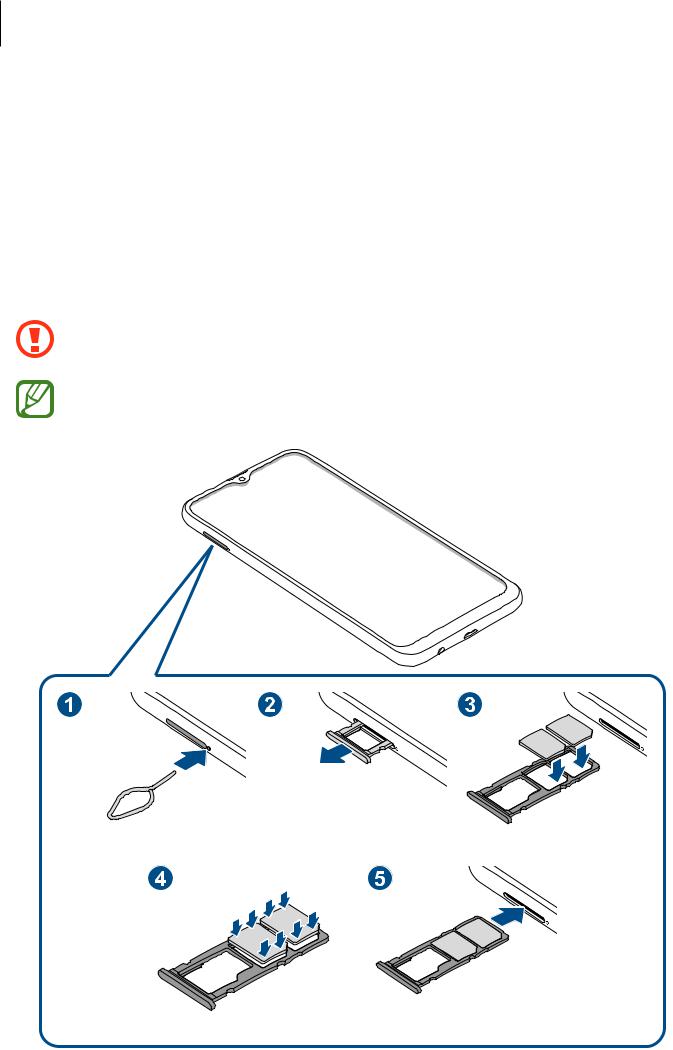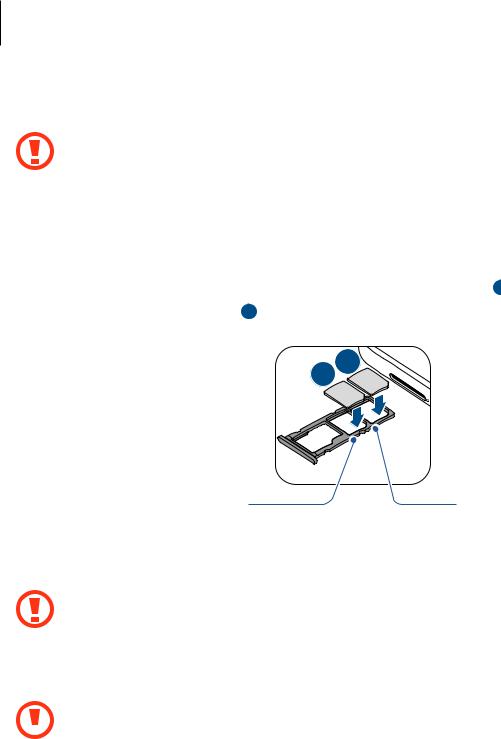Samsung SM-M105F, SM-M105G, SM-M105Y User Guide

USER MANUAL
SM-M105F/DS
SM-M105G
SM-M105G/DS
SM-M105Y/DS
English. 02/2019. Rev.1.0 |
www.samsung.com |
Table of Contents
Basics
4 Read me first
6Device overheating situations and solutions
9 Device layout and functions
13 Battery
16 SIM or USIM card (nano-SIM card)
20 Memory card (microSD card)
24Turning the device on and off
25Initial setup
27 Samsung account
29Transferring data from your previous device
33 Understanding the screen
46 Notification panel
48 Entering text
Apps and features
51 Installing or uninstalling apps
53 Phone
58 Contacts
62 Messages
66 Internet
68Email
69Camera
80Gallery
87Multi window
90Samsung Members
91Samsung Notes
91Calendar
93Radio
94Voice Recorder
95My Files
95Clock
97Calculator
97Game Launcher
100Sharing content
101Google apps
2

Table of Contents
Settings |
Appendix |
||
103 |
Introduction |
133 Troubleshooting |
|
103 |
Connections |
|
|
|
104 |
Wi-Fi |
|
|
106 |
Bluetooth |
|
|
108 |
Data saver |
|
|
108 |
Mobile Hotspot and Tethering |
|
|
110 |
SIM card manager |
|
|
110 |
More connection settings |
|
112Sounds and vibration
113 Dolby Atmos (surround sound)
113Notifications
114Display
115 Screensaver
115Wallpapers and themes
116Advanced features 117 Dual Messenger
118 Device maintenance
122 Apps
122Lock screen 123 Smart Lock
123Biometrics and security 124 Face recognition
127Cloud and accounts 128 Backup and restore
128Google
129Accessibility
130General management
131Software update
132User manual
132 About phone
3
Basics
Read me first
Please read this manual before using the device to ensure safe and proper use.
•Descriptions are based on the device’s default settings.
•Some content may differ from your device depending on the region, service provider, model specifications, or device’s software.
•Content (high quality content) that requires high CPU and RAM usage will affect the overall performance of the device. Apps related to the content may not work properly depending on the device’s specifications and the environment that it is used in.
•Samsung is not liable for performance issues caused by apps supplied by providers other than Samsung.
•Samsung is not liable for performance issues or incompatibilities caused by edited registry settings or modified operating system software. Attempting to customise the operating system may cause the device or apps to work improperly.
•Software, sound sources, wallpapers, images, and other media provided with this device are licensed for limited use. Extracting and using these materials for commercial or other purposes is an infringement of copyright laws. Users are entirely responsible for illegal use of media.
•You may incur additional charges for data services, such as messaging, uploading and downloading, auto-syncing, or using location services depending on your data plan. For large data transfers, it is recommended to use the Wi-Fi feature.
•Default apps that come with the device are subject to updates and may no longer be supported without prior notice. If you have questions about an app provided with the device, contact a Samsung Service Centre. For user-installed apps, contact service providers.
4

Basics
•Modifying the device’s operating system or installing softwares from unofficial sources may result in device malfunctions and data corruption or loss. These actions are violations of your Samsung licence agreement and will void your warranty.
•Depending on the region or service provider, a screen protector is attached for protection during production and distribution. Damage to the attached screen protector is not covered by the warranty.
•You can see the touchscreen clearly even in strong outdoor sunlight by automatically adjusting the contrast range based on the surrounding environment. Due to the nature of the product, displaying fixed graphics for extended periods may result in afterimages (screen burn-in) or ghosting.
––It is recommended not to use fixed graphics on part or all of the touchscreen for extended periods and turn off the touchscreen when not using the device.
––You can set the touchscreen to turn off automatically when you are not using it. Launch the Settings app, tap Display →Screen timeout, and then select the length of time you want the device to wait before turning off the touchscreen.
––To set the touchscreen to automatically adjust its brightness based on the surrounding environment, launch the Settings app and tap Display →Auto brightness.
•Depending on the region or model, some devices are required to receive approval from the Federal Communications Commission (FCC). If your device is approved by the FCC, you can view the FCC ID of the device. To view the FCC ID, launch the Settings app and tap About phone →Status.
•Depending on the region, you can view the regulatory information on the device. To view the information, launch the Settings app and tap About phone →Regulatory information.
Instructional icons
Warning: situations that could cause injury to yourself or others
Caution: situations that could cause damage to your device or other equipment
Notice: notes, usage tips, or additional information
5

Basics
Device overheating situations and solutions
When the device heats up while charging the battery
While charging, the device and the charger may become hot. During wireless charging or fast charging, the device may feel hotter to the touch. This does not affect the device’s lifespan or performance and is in the device’s normal range of operation. If the battery becomes too hot, the charger may stop charging.
Do the following when the device heats up:
•Disconnect the charger from the device and close any running apps. Wait for the device to cool down and then begin charging the device again.
•If the lower part of the device overheats, it could be because the connected USB cable is damaged. Replace the damaged USB cable with a new Samsung-approved one.
•When using a wireless charger, do not place foreign materials, such as metal objects, magnets, and magnetic stripe cards, between the device and the wireless charger.
The wireless charging or fast charging feature is only available on supported models.
6

Basics
When the device heats up during use
When you use features or apps that require more power or use them for extended periods, your device may temporarily heat up due to increased battery consumption. Close any running apps and do not use the device for a while.
The following are examples of situations in which the device may overheat. Depending on the functions and apps you use, these examples may not apply to your model.
•During the initial setup after purchase or when restoring data
•When downloading large files
•When using apps that require more power or using apps for extended periods
––When playing high-quality games for extended periods
––When recording videos for extended periods
––When streaming videos while using the maximum brightness setting
––When connecting to a TV
•While multitasking (or, when running many apps in the background)
––When using Multi window
––When updating or installing apps while recording videos
––When downloading large files during a video call
––When recording videos while using a navigation app
•When using large amount of data for syncing with the cloud, email, or other accounts
•When using a navigation app in a car while the device is placed in direct sunlight
•When using the mobile hotspot and tethering feature
•When using the device in areas with weak signals or no reception
•When charging the battery with a damaged USB cable
•When the device’s multipurpose jack is damaged or exposed to foreign materials, such as liquid, dust, metal powder, and pencil lead
•When you are roaming
7

Basics
Do the following when the device heats up:
•Keep the device updated with the latest software.
•Conflicts between running apps may cause the device to heat up. Restart the device.
•Deactivate the Wi-Fi, GPS, and Bluetooth features when not using them.
•Close apps that increase battery consumption or that run in the background when not in use.
•Delete unnecessary files or unused apps.
•Decrease the screen brightness.
•If the device overheats or feels hot for a prolonged period, do not use it for a while. If the device continues to overheat, contact a Samsung Service Centre.
Device limitations when the device overheats
When the device heats up, the features and performance may be limited or the device may turn off to cool down. The feature is only available on supported models.
•If the device becomes hotter than usual, a device overheating message will appear. To lower the device’s temperature, the screen brightness and the performance speed will be limited and battery charging will stop. Running apps will be closed and you will only be able to make emergency calls until the device cools down.
•If the device overheats or feels hot for a prolonged period, a power off message will appear. Turn off the device, and wait until it cools down.
8

Basics
Precautions for operating environment
Your device may heat up due to the environment in the following conditions. Use caution to avoid shortening the battery’s lifespan, damaging the device, or causing a fire.
•Do not store your device in very cold or very hot temperatures.
•Do not expose your device to direct sunlight for extended periods.
•Do not use or store your device for extended periods in very hot areas, such as inside a car in the summertime.
•Do not place the device in any areas that may overheat, such as on an electric heating mat.
•Do not store your device near or in heaters, microwaves, hot cooking equipment, or high pressure containers.
•Never use a damaged charger or battery.
Device layout and functions
Package contents
Refer to the quick start guide for package contents.
•The items supplied with the device and any available accessories may vary depending on the region or service provider.
•The supplied items are designed only for this device and may not be compatible with other devices.
•Appearances and specifications are subject to change without prior notice.
•You can purchase additional accessories from your local Samsung retailer. Make sure they are compatible with the device before purchase.
•Use only Samsung-approved accessories. Using unapproved accessories may cause the performance problems and malfunctions that are not covered by the warranty.
•Availability of all accessories is subject to change depending entirely on manufacturing companies. For more information about available accessories, refer to the Samsung website.
9

Basics
Device layout
Proximity sensor |
Speaker |
Front camera |
|
|
Volume key |
|
Power key |
Touchscreen
Multipurpose jack
Microphone
 GPS antenna
GPS antenna
Rear camera (Dual)
 SIM card / Memory card
SIM card / Memory card
tray
Flash
Speaker
Main antenna
 Earphone jack
Earphone jack
Microphone
10

Basics
• When using the speakers, such as when playing media files or using speakerphone, do not place the device close to your ears.
•Be careful not to expose the camera lens to a strong light source, such as direct sunlight. If the camera lens is exposed to a strong light source, such as direct sunlight, the camera image sensor may be damaged. A damaged image sensor is irreparable and will cause dots or spots in pictures.
•If you use the device with its glass or acrylic body broken, there may be a risk of injury. Use the device only after it has been repaired at a Samsung Service Centre.
•Connectivity problems and battery drain may occur in the following situations:
––If you attach metallic stickers on the antenna area of the device
––If you attach a device cover made with metallic material to the device
––If you cover the device’s antenna area with your hands or other objects while using certain features, such as calls or the mobile data connection
•Using a Samsung-approved screen protector is recommended. Unapproved screen protectors may cause the sensors to malfunction.
•Do not cover the proximity sensor area with screen accessories, such as a screen protector or stickers. Doing so may cause the sensor to malfunction.
•Do not allow water to contact the touchscreen. The touchscreen may malfunction in humid conditions or when exposed to water.
11

Basics
Hard keys
|
|
Volume key |
|
|
|
Power key |
|
Key |
Function |
||
Power |
• |
Press and hold to turn the device on or off. |
|
• |
Press to turn on or lock the screen. |
||
|
|||
Volume |
• |
Press to adjust the device volume. |
|
Soft buttons
Recents button |
Back button |
Home button
When you turn on the screen, the soft buttons will appear at the bottom of the screen. The soft buttons are set to the Recents button, Home button, and Back button by default. Refer to Navigation bar (soft buttons) for more information.
12

Basics
Battery
Charging the battery
Charge the battery before using it for the first time or when it has been unused for extended periods.
1
2
Use only Samsung-approved chargers, batteries, and cables. Unapproved chargers or cables can cause the battery to explode or damage the device.
Connecting the charger improperly may cause serious damage to the device. Any damage caused by misuse is not covered by the warranty.
To save energy, unplug the charger when not in use. The charger does not have a power switch, so you must unplug the charger from the electric socket when not in use to avoid wasting power. The charger should remain close to the electric socket and easily accessible while charging.
Connect the USB cable to the USB power adaptor.
Plug the USB cable into the device’s multipurpose jack.
13

Basics
3
4
Plug the USB power adaptor into an electric socket.
After fully charging, disconnect the charger from the device. Then, unplug the charger from the electric socket.
Reducing the battery consumption
Your device provides various options that help you conserve battery power.
•Optimise the device using the device maintenance feature.
•When you are not using the device, turn off the screen by pressing the Power key.
•Activate power saving mode.
•Close unnecessary apps.
•Deactivate the Bluetooth feature when not in use.
•Deactivate auto-syncing of apps that need to be synced.
•Decrease the backlight time.
•Decrease the screen brightness.
14

Basics
Battery charging tips and precautions
•When the battery power is low, the battery icon appears empty.
•If the battery is completely discharged, the device cannot be turned on immediately when the charger is connected. Allow a depleted battery to charge for a few minutes before turning on the device.
•If you use multiple apps at once, network apps, or apps that need a connection to another device, the battery will drain quickly. To avoid losing power during a data transfer, always use these apps after fully charging the battery.
•Using a power source other than the charger, such as a computer, may result in a slower charging speed due to a lower electric current.
•The device can be used while it is charging, but it may take longer to fully charge the battery.
•If the device receives an unstable power supply while charging, the touchscreen may not function. If this happens, unplug the charger from the device.
•While charging, the device and the charger may heat up. This is normal and should not affect the device’s lifespan or performance. If the battery gets hotter than usual, the charger may stop charging.
•If you charge the device while the multipurpose jack is wet, the device may be damaged. Thoroughly dry the multipurpose jack before charging the device.
•If the device is not charging properly, take the device and the charger to a Samsung Service Centre.
15

Basics
SIM or USIM card (nano-SIM card)
Installing the SIM or USIM card
Insert the SIM or USIM card provided by the mobile telephone service provider.
You can insert two SIM or USIM cards so you can have two phone numbers or service providers for a single device. In some areas, data transfer speeds may be slower if two SIM cards are inserted in the device than when one SIM card is inserted.
Use caution not to lose or let others use the SIM or USIM card. Samsung is not responsible for any damages or inconveniences caused by lost or stolen cards.
Some LTE services may not be available depending on the service provider. For more information about service availability, contact your service provider.
16

Basics
1 Insert the ejection pin into the hole next to the tray to loosen the tray.
Ensure that the ejection pin is perpendicular to the hole. Otherwise, the device may be damaged.
2
3
Pull out the tray gently from the tray slot.
Place the SIM or USIM card on the tray with the gold-coloured contacts facing downwards. Place the primary SIM or USIM card on the tray 1 ( 1 ) and the secondary SIM or USIM card on the tray 2 ( 2 ).
1 2
Tray 1 Tray 2
4 Gently press the SIM or USIM card into the tray to secure it.
If the card is not fixed firmly into the tray, the SIM card may leave or fall out of the tray.
5 Insert the tray back into the tray slot.
|
• |
If you insert the tray into your device while the tray is wet, your device may be |
|
• |
damaged. Always make sure the tray is dry. |
|
||
|
||
|
Fully insert the tray into the tray slot to prevent liquid from entering your device. |
17

Basics
Correct card installation
 Nano-SIM card 2
Nano-SIM card 2
Nano-SIM card 1 
 microSD card
microSD card
Use only a nano-SIM card.
Removing the SIM or USIM card
1
2
3
4
Insert the ejection pin into the hole next to the tray to loosen the tray. Pull out the tray gently from the tray slot.
Remove the SIM or USIM card.
Insert the tray back into the tray slot.
18

Basics
Using dual SIM or USIM cards
If you insert two SIM or USIM cards, you can have two phone numbers or service providers for a single device.
Activating SIM or USIM cards
Launch the Settings app and tap Connections →SIM card manager. Select a SIM or USIM card and tap the switch to activate it.
Customising SIM or USIM cards
Launch the Settings app, tap Connections →SIM card manager, and then select a SIM or USIM card to access the following options:
•Icon: Change the icon of the SIM or USIM card.
•Name: Change the display name of the SIM or USIM card.
•Network mode: Select a network type to use with the SIM or USIM card.
Setting preferred SIM or USIM cards
When two cards are activated, you can assign voice calls, messaging, and data services to specific cards.
Launch the Settings app, tap Connections →SIM card manager, and then set the feature preferences for your cards in PREFERRED SIM CARD.
19

Basics
Memory card (microSD card)
Installing a memory card
Your device’s memory card capacity may vary from other models and some memory cards may not be compatible with your device depending on the memory card manufacturer and type. To view your device’s maximum memory card capacity, refer to the Samsung website.
• Some memory cards may not be fully compatible with the device. Using an incompatible card may damage the device or the memory card, or corrupt the data stored in it.
•Use caution to insert the memory card right-side up.
•The device supports the FAT and the exFAT file systems for memory cards. When inserting a card formatted in a different file system, the device will ask to reformat the card or will not recognise the card. To use the memory card, you must format it. If your device cannot format or recognise the memory card, contact the memory card manufacturer or a Samsung Service Centre.
•Frequent writing and erasing of data shortens the lifespan of memory cards.
•When inserting a memory card into the device, the memory card’s file directory appears in the My Files →SD card folder.
20

Basics
1 |
Insert the ejection pin into the hole next to the tray to loosen the tray. |
|
Ensure that the ejection pin is perpendicular to the hole. Otherwise, the device may |
|
be damaged. |
2 |
Pull out the tray gently from the tray slot. |
|
When you remove the tray from the device, the mobile data connection will be |
|
disabled. |
21

Basics
3 Place a memory card on the memory card tray with the gold-coloured contacts facing downwards.
Memory card tray
4 Gently press the memory card into the tray to secure it.
If the card is not fixed firmly into the tray, the memory card may leave or fall out of the tray.
5 Insert the tray back into the tray slot.
|
• |
If you insert the tray into your device while the tray is wet, your device may be |
|
• |
damaged. Always make sure the tray is dry. |
|
||
|
||
|
Fully insert the tray into the tray slot to prevent liquid from entering your device. |
Removing the memory card
Before removing the memory card, first unmount it for safe removal.
Launch the Settings app and tap Device maintenance →Storage → →Storage settings →SD card →UNMOUNT.
→Storage settings →SD card →UNMOUNT.
1
2
Insert the ejection pin into the hole next to the tray to loosen the tray.
Pull out the tray gently from the tray slot.
22

Basics
3
4
Remove the memory card.
Insert the tray back into the tray slot.
Do not remove external storage, such as a memory card or USB storage, while the device is transferring or accessing information, or right after transferring data. Doing so can cause data to be corrupted or lost or cause damage to the external storage or device. Samsung is not responsible for losses, including loss of data, resulting from the misuse of external storage devices.
Formatting the memory card
A memory card formatted on a computer may not be compatible with the device. Format the memory card on the device.
Launch the Settings app and tap Device maintenance →Storage → →Storage settings →SD card →Format.
→Storage settings →SD card →Format.
Before formatting the memory card, remember to make backup copies of all important data stored in the memory card. The manufacturer’s warranty does not cover loss of data resulting from user actions.
23

Basics
Turning the device on and off
Press and hold the Power key for a few seconds to turn on the device.
When you turn on your device for the first time or after performing a data reset, follow the onscreen instructions to set up your device.
To turn off the device, press and hold the Power key, and then tap Power off.
Follow all posted warnings and directions from authorised personnel in areas where the use of wireless devices is restricted, such as aeroplanes and hospitals.
Restarting the device
To restart the device, press and hold the Power key, and then tap Restart.
If your device is frozen and unresponsive, press and hold the Power key and the Volume Down key simultaneously for more than 7 seconds to restart it.

 Volume Down key
Volume Down key
Power key
Emergency mode
You can switch the device to emergency mode to reduce battery consumption. Some apps and functions will be restricted. In emergency mode, you can make an emergency call, send your current location information to others, sound an emergency alarm, and more.
Activating emergency mode
To activate emergency mode, press and hold the Power key, and then tap Emergency mode.
The usage time left shows the time remaining before the battery power runs out. Usage time left may vary depending on your device settings and operating conditions.
24

Basics
Deactivating emergency mode
To deactivate emergency mode, tap  →Turn off Emergency mode. Alternatively, press and hold the Power key, and then tap Emergency mode.
→Turn off Emergency mode. Alternatively, press and hold the Power key, and then tap Emergency mode.
Initial setup
When you turn on your device for the first time or after performing a data reset, follow the onscreen instructions to set up your device.
The initial setup procedures may vary depending on the device’s software and your region.
1
2
Turn on the device.
Select your preferred device language and select  .
.
Select a language.
25

Basics
3 Select a Wi-Fi network and connect to it.
If you do not connect to a Wi-Fi network, you may not be able to set up some device features during the initial setup.
4
5
Follow the on-screen instructions to proceed the initial setup.
Set a screen lock method to protect your device. You can protect your personal information by preventing others from accessing your device. To set the screen lock method later, tap No, thank you.
6 Sign in to your Samsung account. You can enjoy Samsung services and keep your data up to date and secure across all of your devices. Refer to Samsung account for more information.
7 Select features you want to use and complete the initial setup. The Home screen will appear.
26

Basics
Samsung account
Introduction
Your Samsung account is an integrated account service that allows you to use a variety of Samsung services provided by mobile devices, TVs, and the Samsung website. Once your Samsung account has been registered, you can keep your data up to date and secure across your Samsung devices with Samsung Cloud, track and control your lost or stolen device, see tips and tricks from Samsung Members, and more.
Create your Samsung account with your email address.
To check the list of services that can be used with your Samsung account, visit account.samsung.com. For more information on Samsung accounts, launch the Settings app and tap Cloud and accounts →Accounts →Samsung account → →Help.
→Help.
Registering your Samsung account
Registering a new Samsung account
If you do not have a Samsung account, you should create one.
1
2
3
Launch the Settings app and tap Cloud and accounts →Accounts →Add account → Samsung account.
Alternatively, launch the Settings app and tap  .
.
Tap CREATE ACCOUNT.
Follow the on-screen instructions to complete creating your account.
27

Basics
Registering an existing Samsung account
If you already have a Samsung account, register it to the device.
1
2
3
Launch the Settings app and tap Cloud and accounts →Accounts →Add account → Samsung account.
Alternatively, launch the Settings app and tap  .
.
Tap SIGN IN.
Enter your Samsung account ID and password and tap SIGN IN.
1 |
Launch the Settings app and tap Cloud and accounts →Accounts. |
2 |
Tap Samsung account → →Remove account. |
3 |
Tap REMOVE, enter your Samsung account password, and then tap REMOVE ACCOUNT. |
28

Basics
Transferring data from your previous device
You can restore your data, such as images, contacts, messages, and apps from Samsung Cloud. You can also copy them from your previous device via Smart Switch.
•This feature may not be supported on some devices or computers.
•Limitations apply. Visit www.samsung.com/smartswitch for details. Samsung takes copyright seriously. Only transfer content that you own or have the right to transfer.
Smart Switch
Transfer data between mobile devices via Smart Switch. To use Smart Switch, launch the
Settings app and tap Cloud and accounts →Smart Switch. If you do not have the app, download it from Galaxy Apps.
Transferring data from a mobile device
Transfer data from your previous device to your device wirelessly via Wi-Fi Direct.
1
2
3
On the previous device, launch Smart Switch.
If you do not have the app, download it from Galaxy Apps.
On your device, launch the Settings app and tap Cloud and accounts →Smart Switch.
Place the devices near each other.
29

Basics
4
5
6
7
On the previous device, tap Send data →Wireless.
On the previous device, select an item to transfer and tap SEND.
On your device, tap RECEIVE.
Follow the on-screen instructions to transfer data from your previous device.
Transferring data using external storage
Transfer data using external storage, such as a microSD card.
1
2
3
4
Transfer data from your previous device to external storage.
Insert or connect the external storage device to your device.
On your device, launch the Settings app and tap Cloud and accounts →Smart Switch → →Restore.
→Restore.
Follow the on-screen instructions to transfer data from external storage.
Transferring backup data from a computer
Transfer data between your device and a computer. You must download the Smart Switch computer version app from www.samsung.com/smartswitch. Back up data from your previous device to a computer and import the data to your device.
1
2
On the computer, visit www.samsung.com/smartswitch to download Smart Switch.
On the computer, launch Smart Switch.
If your previous device is not a Samsung device, back up data to a computer using a program provided by the device’s manufacturer. Then, skip to the fifth step.
30
